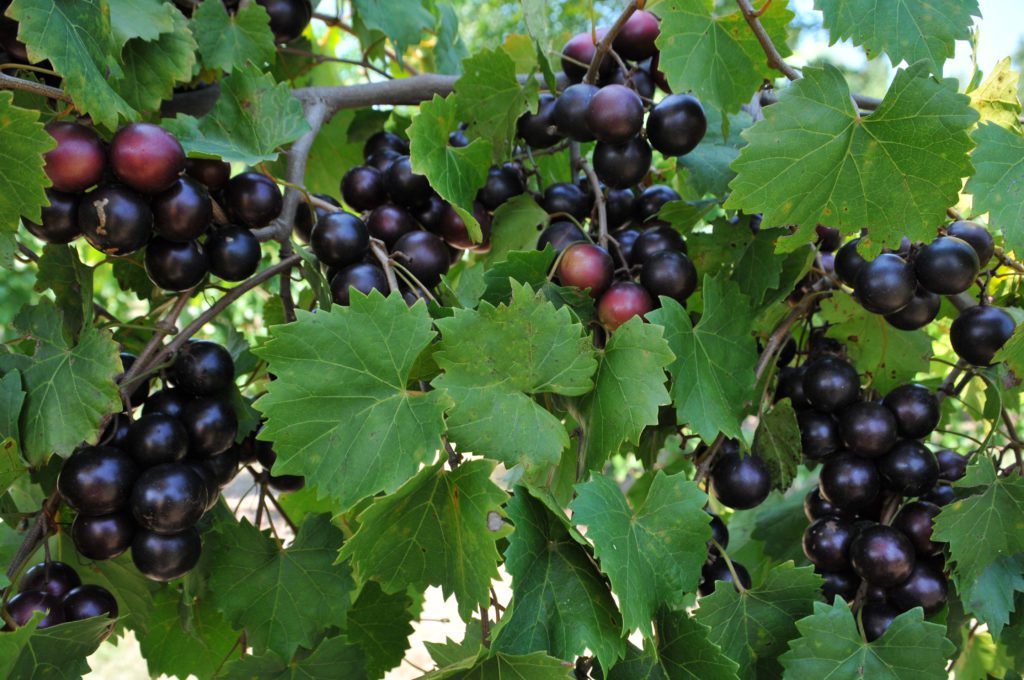Jessica Strickland is an Agriculture Extension Agent, specializing in horticulture for North Carolina Cooperative Extension in Wayne County.
Muscadine grapes (Vitis rotundifolia) are a unique grape species native to the southeastern United States. They are well-adapted to warm, humid climates and have been grown since the 16th century. Muscadines are popular for fresh eating, juices, jellies and wine production. Proper pruning is essential for managing vigor and maximizing fruit production in muscadine vines. Knowing when to cut back muscadine vines is key to getting the timing right.
Why Cutting Back is Important
Cutting back muscadine vines serves several important purposes:
- Removes old, unproductive wood to encourage new, fruitful growth Muscadines fruit on shoots arising from last year’s growth
- Maintains a balanced framework of renewal spurs and fruiting wood.
- Allows light and air penetration which reduces disease.
- Manages vigor and improves fruit quality, Overly vigorous vines produce inferior fruit,
- Maximizes yields by achieving an optimal balance of vegetative growth and fruiting wood.
- Facilitates spraying, harvesting and other care of the vines.
When to Cut Back Mature Vines
The optimal time to prune muscadine vines is during the dormant season after they have lost their leaves This is generally from December through February The reasons are
- Pruning during dormancy minimizes sap bleeding from wounds.
- It is easier to assess vine structure without leaves in the way.
- Cuts heal quickly when sap flow begins in spring.
- Cold temperatures preclude insect/disease transmission on tools.
- Dormant vines are less susceptible to Eutypa dieback, a pruning-associated fungal disease.
Some growers prune immediately after harvest (August/September) to remove excessive vegetation and improve light exposure. However, this practice is more likely to promote Eutypa infections. It’s better to leave clean-up pruning until full dormancy.
The Pruning Process
Follow these steps when cutting back muscadine vines:
- Remove all dead, damaged or diseased wood. This is a sanitation step to prevent disease carryover.
- Select the best 8-10 renewal spurs per vine. These should be spaced 6-10 inches apart along the trellis wire.
- Remove all other shoots back to their point of origin. This prevents overcrowding and maintains an optimal number of fruiting buds.
- Shorten retained renewal spurs to 2-3 buds. The lowest bud will produce a non-fruitful shoot. Upper buds will develop fruiting wood.
- Cut back side shoots arising from renewal spurs to 1-2 buds. These will bear the current season’s fruit.
- Trim excess growth beyond the trellis. Laterals should not extend more than 12-18 inches past the trellis wire.
Taking out 85-90% of last year’s growth may seem drastic, but it is necessary to maximize fruitfulness. The key is leaving the right amount of fruitful wood. Leaving too much leads to poor quality fruit.
Cutting Back Young Vines
Pruning strategies differ in young, non-bearing vines. The goals are to:
- Establish a strong trunk and lateral framework.
- Delay fruiting until the vine is mature enough to support a crop.
- Encourage vegetative growth for good vine vigor.
For the first 2 years, prune off all flower clusters as they appear. This allows the vine to direct energy into growth rather than fruit production. Remove all but the best shoot arising from each node to shape the vine. Head back laterals to 6-8 buds to develop short spurs.
In year 3, allow flower clusters on basal spurs to set a small crop. Still remove clusters nearer the end of shoots to maintain vegetative growth. Gradually increase fruiting as vines mature over 4-5 years.
Pruning Tools
Use clean, sharp bypass hand pruners for making cuts up to 1⁄2 inch diameter. Lopping shears are better for thicker wood. Sterilize tools before each vine with diluted bleach, alcohol or other disinfectants. This prevents spreading diseases between vines.
Timing Summary
- Dormant season pruning (December-February) is best for mature, fruiting vines.
- Prune immediately after harvest only for excess foliage removal. Follow up with dormant pruning.
- Prune young vines in early spring before bud break.
- Remove all flowers in first 2 years on young vines.
- Gradually allow more fruiting as vines mature.
Properly timing when to cut back muscadine vines is important for maintaining their health, structure and productivity. Dormant pruning balances vegetative vigor and fruiting wood to maximize yields of high quality grapes. With the right technique and timing, muscadine vines will provide bountiful harvests for many years to come.

Pruning Muscadines
FAQ
What happens if you don’t prune muscadine vines?
What month is best to prune grape vines?
When to prune muscadine vines in Florida?
When should you trim muscadine vines?
Trim back lateral (side) growth on the cordons to one foot (0.5 m.) lengths to encourage rapid growth and development. From here on in, trimming muscadine vines will be a dormant season chore. January through February is the ideal time for pruning these vines and the process is fairly simple.
How long does it take for muscadine grapes to produce fruit?
Muscadine grapes take approximately 100-120 days to produce fruit, which is 4-6 weeks. Many of these are used to make wines. There are many varieties and species.
Can muscadine vines be cut back?
You can start from scratch and cut the vine all the way back to the original trunk with drastic pruning. Muscadine grapevines are tough and most will survive the shock. However, to keep the vines producing while you bring the plant back under control, you might consider pruning only one side of the trunk or one cordon at a time.
How to prune muscadine grapevines?
There is one more area that should be covered: how to prune muscadine grapevines that have been neglected and are seriously overgrown. You can start from scratch and cut the vine all the way back to the original trunk with drastic pruning. Muscadine grapevines are tough and most will survive the shock.
Should Muscadines be pruned?
Without proper pruning, muscadines are doomed to become tangled masses of woody vines bearing little or no fruit. Old wood must be cut away to make room for new growth, as it is new growth that produces fruit. Vines with too much old wood will not bloom and bear fruit. Those with too much growth will not produce well either.
How do you care for muscadine vines?
A well-trained muscadine plant consists of a single trunk and 2 to 4 trellised arms or cordons and smaller fruiting stems called spurs. If the vines have been neglected for more than a year start by working in small sections to prevent being overwhelmed. Annual upkeep makes the pruning process much simpler.
- The Ultimate Guide to Growing Strawberries in Raised Beds - August 8, 2025
- No-Dig Garden Beds: The Easiest Way to Grow a Beautiful Garden - August 6, 2025
- How to Protect and Preserve Wood for Raised Garden Beds - August 6, 2025
